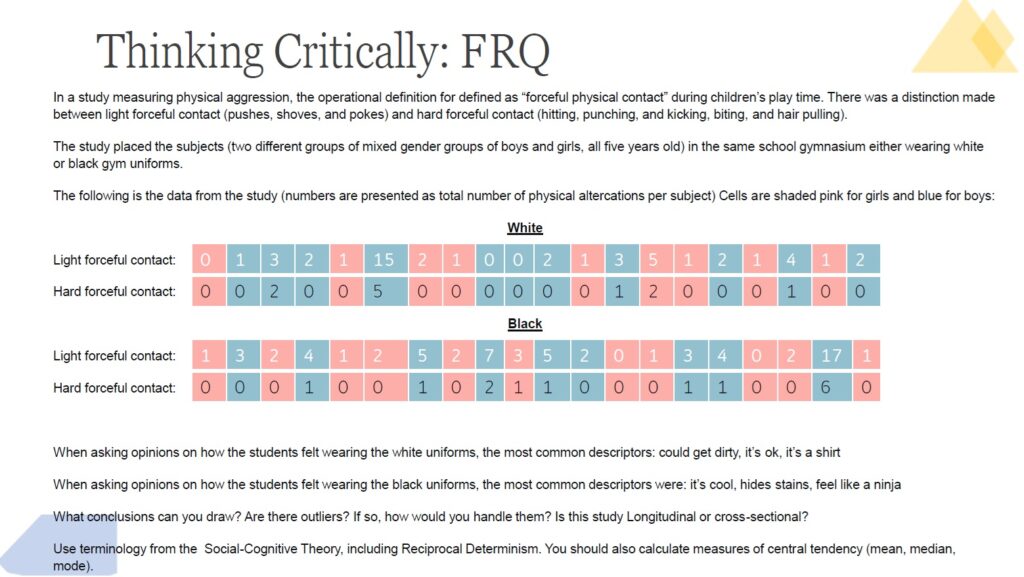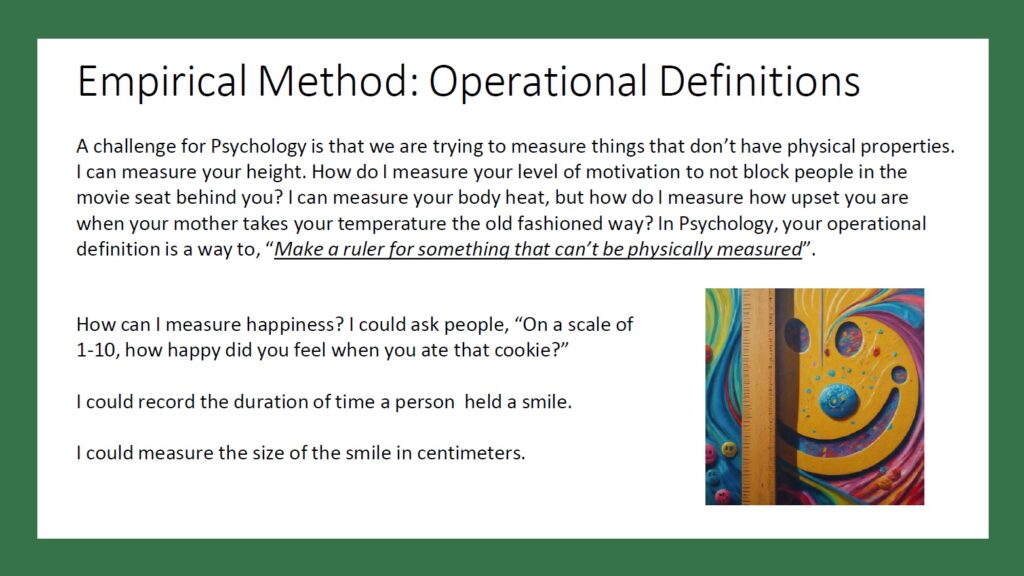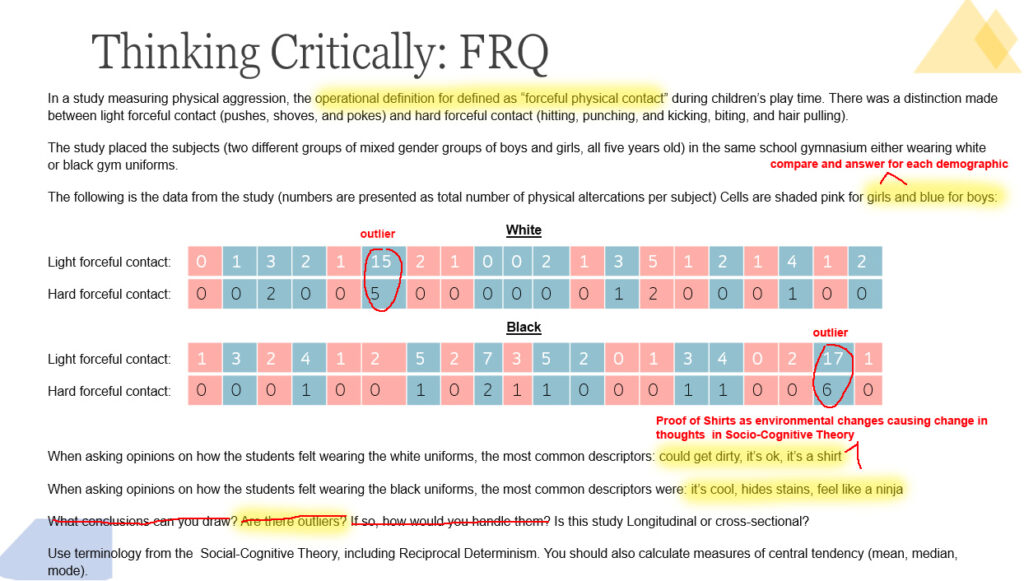

The New 2024 AP Psychology Test FRQs: AAQ and EBQ
Have you heard the news? AP Psychology just received one of the biggest changes to an AP Course ever. Yes, your students still need to know over 500 terms for the MCQ portion of the test, but, more importantly, students now need to be skilled in experimental design and analysis, including some basic statistics to answer the AAQs and EBQs (Article Analysis Questions and Evidence Based Questions). What type of questions should they be able to answer, and how can you prepare? First, download the new course guide from AP Central. Second, let’s take a look at a sample Free Response Question and examine the teaching strategies and knowledge you’ll have to impart to your students.
A sample Psychology AAQ Free Respons Question for 2024
If you need an EBQ, read here. For this AAQ, We’ll use a sample AAQ FRQ taken (with permission) from this AP Psychology course:

The question:
In a study measuring physical aggression, the operational definition for defined as “forceful physical contact” during children’s play time. There was a distinction made between light forceful contact (pushes, shoves, and pokes) and hard forceful contact (hitting, punching, and kicking, biting, and hair pulling).
The study placed the subjects (two different groups of mixed gender groups of boys and girls, all five years old) in the same school gymnasium either wearing white or black gym uniforms.
The following is the data from the study (numbers are presented as total number of physical altercations per subject) Cells are shaded pink for girls and blue for boys (We’ve added a G or B to the text data below to indicate gender):
White shirts
| G0 | B1 | B3 | B2 | G1 | B15 | G2 | G1 | B0 | B0 | B2 | G1 | B3 | G5 | G1 | B2 | G1 | B4 | G1 | B2 |
| G0 | B0 | B2 | B0 | G0 | B5 | G0 | G0 | B0 | B0 | B0 | G0 | B1 | G2 | G0 | B0 | G0 | B1 | G0 | B0 |
Black shirts
| G1 | B3 | G2 | B4 | G1 | G2 | B5 | G2 | B7 | G3 | B5 | B2 | G0 | G1 | B3 | B4 | G0 | G2 | B17 | G1 |
| G0 | B0 | G0 | B1 | G0 | G0 | B1 | G0 | B2 | G1 | B1 | B0 | G0 | G0 | B1 | B1 | G0 | G0 | B6 | G0 |
When asking opinions on how the students felt wearing the white uniforms, the most common descriptors: could get dirty, it’s ok, it’s a shirt
When asking opinions on how the students felt wearing the black uniforms, the most common descriptors were: it’s cool, hides stains, feel like a ninja
What conclusions can you draw? Are there outliers? If so, how would you handle them? Is this study Longitudinal or cross-sectional?
Use terminology from the Social-Cognitive Theory, including Reciprocal Determinism. You should also calculate measures of central tendency (mean, median, mode).
How to Analyze Psychology Free Response Questions: AAQ
Demographics: When looking at this question, the first thing students should pay attention to is the demographic information. The fact that the question has taken the time to differentiate data between boys and girls means the student should pay attention to this in their response. Students need to consider what type of sampling occurred (was this random sampling? Were students taken from a data pool of students who were already given time out for aggressive behavior? Was this a stratified random sample?). If a question mentions differences in age, gender, income, nationality, etc in the question, it is going to be an important part of the question to answer. In this answer, as we’ll see below, the aggression of one gender could be affecting the aggression of another, and not just the presence of a white or black shirt, should be considered. Students should be aware how the presence of a researcher (the Hawthorne effect), or other variables or populations, can be affecting their results due to confounding variables.
Averages: Because the data set included an extreme outlier, students should consider removing the outlier before calculating the mean. If they keep the outlier in, they should be able to report that the mean may be skewed by an outlier, and also report the mode or median average. Students need to know the basics of statistical analysis regarding measures of central tendency and the flaws in a mean average with populations that have an extremely wide difference in values for each data point.
Operational Definitions: Students should be able to analyze if an operational definition is accurate and reliable. Does it measure what it is supposed to measure? This study measured “aggression” using the number of incidents of physical contact made. Is the operational definition valid in this case? Students should be able to have deep knowledge of how operational definitions can accidently measure incorrectly. In this case, would students playing tag count as light contact? A tap on the shoulder? They should be able to consider how this could induce bias or confounding variables. Considering this question mentions terms from the Social Psychology unit, this should be a clue that observer perceptions and bias should be considered in the answer. Make sure students know the context of terms as they may relate to an answer.

Types of Study: This question specifically asks if it is longitudinal or cross-sectional. Students should know both of these, as well as case studies, observational research, family studies, and more. Go over these again in every unit to refresh their memory.
Highlight and mark each question: This particular free response question is asking students to answer multiple things. Students are allowed to make marks on their test materials, so students should go through and highlight or underline each question and cross it out as they answer it to ensure they are not failing to answer any part of a question. Teach students to do this for each FRQ you assign.

(Image taken from Diogenes AP Psychology Course 2024, used with permission)
Answering an AP Psychology 2024 Free Response Question AAQ
The course we pulled this question from includes answers to their Free Response Questions. To prepare your students for the AP test, it’s even more important to discuss answers as a class on FRQ than it is on Multiple Choice Questions. The answer provided is as follows:


White
Operational definition: The operational definitions are defined as “light” or “hard forceful contact”, and experimenters noted the difference between the two.
Light forceful contact:
Mean: 2.35
Median: 1.5
Mode: 1
The boy who had 15/5 contacts is an extreme outlier and should be removed from the data, giving the following revised results
Mean: 1.68
Median: 1
Mode: 1
Hard forceful contact:
Mean: 0.55
Median: 0
Mode: 0
The boy who had 15/ 5 contacts is an extreme outlier and should be removed from the data, giving the following revised results
Mean: 0.32
Median: 0
Mode: 0
Black
Light forceful contact:
Mean: 3.25
Median: 2
Mode: 2
The boy who had 17/6 contacts is an extreme outlier and should be removed from the data, giving the following revised results
Mean: 2.53
Median: 2
Mode: 2
Hard forceful contact:
Mean: 0.7
Median: 0
Mode: 0
The boy who had 17/6 contacts is an extreme outlier and should be removed from the data, giving the following revised results
Mean: 0.42
Median: 0
Mode: 0
Answer the AAQ using the RRSEGA format:

Research Method (1 Point)
This study used an observational research design with experimental manipulation. Researchers controlled the independent variable (shirt color) while observing the dependent variable (physical aggression) without direct intervention. The study was cross-sectional, as it measured behavior in a single play session rather than tracking changes over time.
Research Variable (1 Point)
The independent variable in this study was the color of the gym uniforms (white or black), while the dependent variable was physical aggression. The operational definition of aggression was classified into light forceful contact (pushes, shoves, pokes) and hard forceful contact (hitting, punching, kicking, biting, and hair pulling).
Statistic Interpretation (1 Point)
The study found that black uniforms increased physical aggression, particularly among boys.
- Light aggression increased by 50.6% (from 1.68 incidents in white uniforms to 2.53 in black).
- Hard aggression increased by 31.25% (from 0.32 in white to 0.42 in black).
- Boys exhibited significantly higher levels of aggression in both categories:
- Light aggression (white: 1.9, black: 4.125) had a 117.1% increase
- Hard aggression (white: 0.4, black: 0.875) had a 118.75% increase
- Girls showed a slight decrease in aggression in black uniforms:
- Light aggression (white: 1.4, black: 1.34) had a 4.3% decrease
- Hard aggression (white: 0.22, black: 0.09) had a 59.1% decrease
The change was noted that the overall group saw an increase in light physical aggression of 0.85 (1.68 incidents in white to 2.53 in black uniforms), which is a 50.6% increase in light physical aggression due to the change in environment (noted as introduction of black uniforms in the gym).
The change in in hard physical contact was 0.32 to 0.42, a 31.25% increase in hard forceful physical contact.
It is noted that boys have an overall higher level of aggressive acts in both light and hard forceful contact. When controlling for gender:
boys: mean is 1.9 light/white, mean is 0.4 hard/white; boys: mean is 4.125 light/black, mean is 0.875 hard/black;
girls: mean is 1.4 light/white, mean is 0.22 hard/white. girls: mean is 1.34 light/black, mean is 0.09 hard/black.
We can conclude that this study shows girls have a slight decrease in both types of aggression in black, while boys have a 117.1% increase in light forceful contact and a 118.75% increase in hard physical aggression. Girls saw a decrease in light aggression by 4.3% and a decrease in hard aggression by 59.1%.
These results support the Social Cognitive Theory, which suggests that environmental changes (such as wearing black uniforms) influence thoughts and behaviors. The qualitative data from the study supports this, as children in black uniforms associated them with feeling “cool” or “like a ninja”, potentially leading to increased aggression.
Ethical guidelines (1 point)
The study does not mention is consent was gained from parents to include their children in the study, so we can not be sure the study is ethical because informed consent was not made, nor does it explain if the confidentiality of the children was garunteed. Furthermore, the principle of do no harm could be considered to be broken if children were put in a sitution in which they could physical harm each other and the respondants did not step in to stop it, or if they were knowingly put in a situation where harm was more likely to occur based on the research hypothesis.
Generalizability (1 point)
The small sample size of the study means we can’t be sure the results will generalize to other children. Because of the age of the subjects, the results can not be generalized to adults. It is unclear by this study if the decrease in women’s aggression is an effect of the black uniforms, or the increase in men’s aggression. Further study with larger samples would be needed on segregated gender groups to better control for this variable.
Argument (1 point)
Environment can result in changes in the way people think, and thus changes in their behavior, known as reciprocal determinism. A change in the environment (the black-colored uniforms instead of white-uniforms) resulted in increased light physical aggression because it changed their thoughts, as indicated by their answers on the uniform descriptions. It is unknown whether this environmental change from white to black is increasing natural aggression, or if the white uniform is decreasing natural aggression (the complain that it could get dirty may be an environmental factor causing them to play more carefully to prevent stains). Regardless, this study has real world affects in that it could help determine the best uniform color for schools to reduce bullying and aggression.
Are your students ready?
After examining the answer, would the AP Psych students you taught last year have been able to answer the question as provided in the example here? If not, it’s time to start teaching for the new Free Response Questions by focusing on experimental design (demographics and samples, operational definitions and validity, types of studies) and statistical analysis (how to handle outliers; measures of central tendency and the strengths and weakness of mean, median, and mode). Teach students how to take notes on the FRQs so they don’t miss any parts of the question, and they can read between the lines, just like how the qualitative data about opinions on the shirts in the example above should be interpreted as clues for the environmental change leading to thought change according to the Socio-Cognitive Trait theory of personality.
Focus on these aspects of experimental design and statistical analysis and prepare students to answer FRQs on the AP Psychology test. What should you expect for the EBQs? Take a look at a free sample EBQ from the Diogenes Education AP Psychology course here.

